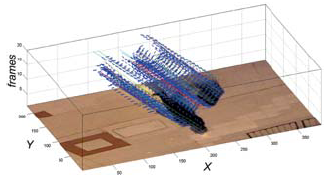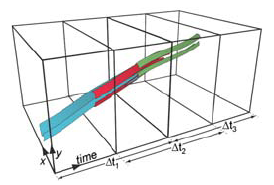twist+1
Compositional representation
We incrementally generated a part-based description by grouping simple local features (edge segments) to part combinations. This part-based representation is built from a large set of features (edge segments) by hierarchically grouping them depending on their spatial and temporal density. The grouping process leads to a set of stable part combinations with increasing complexity, which can efficiently guide a spatio-temporal association step (find correspondences) of coherently moving image regions, which are part of the same target object (see Figures 2 and 3). Figure 1 visualizes the concept of the approach. Videos 1 and 2 show tracking results with this generic, but also highly target specific representation. Related publications [28,39] (see publications).
Figure 1: Concept of our hierarchical compositional representation.

Figure 2: 3D plot of stable combinations belonging to the foreground object.

Figure 3: Spatio-temporal association step. Tracking combinations.

Video 1: Tracking people with partial occlusion.
Video 2: Tracking a car.
Last modified: May 07, 2010 by Nicole M. Artner
